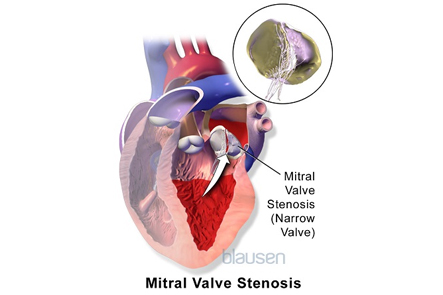A narrow mitral valve that does not allow sufficient blood flow
The mitral valve allows blood to flow between the two left chambers of your heart, the left ventricle and the left atrium. Mitral stenosis does not allow the valve to open properly, decreasing blood flow through the heart. This can lead to pulmonary hypertension, atrial fibrillation, or heart failure.
Our Structural Heart and Valvular Disease Program offers innovative minimally invasive treatment options for heart valve diseases, such as mitral stenosis.
What are mitral stenosis symptoms?

-
Coughing up blood
-
Edema, swelling in the feet or legs
-
Shortness of breath
What can cause mitral stenosis?
The most common cause of mitral stenosis is rheumatic fever, which is rare in the United States. Calcium deposits that build up on the valve or untreated strep infections can also cause mitral stenosis.
Tests
Diagnosing mitral stenosis is the first step to developing a treatment plan. Our specialists may recommend one or more diagnostic and imaging procedures.
Cardiac Catheterization
Cardiac catheterization is a minimally invasive way to diagnose and treat a variety of heart and vascular conditions by guiding thin, flexible tubes called catheters through blood vessels to problem areas.
Chest X-Rays
Chest X-rays use a small dose of radiation to create pictures of the structures inside the chest, including the lungs, heart, and chest wall.
Echocardiogram
An echocardiogram uses high-frequency sound waves to create images of the heart.
Electrocardiogram (ECG)
An electrocardiogram, also known as an ECG, measures the heart’s electrical activity.
Magnetic Resonance Imaging (MRI)
Magnetic resonance imaging, better known as cardiac MRI, is a combination of radio waves, magnets, and computer technology to create images of your heart and blood vessels.
Stress Tests
Stress tests are used to assess how your heart works during physical activity. There are several types of stress tests, including treadmill or bike stress tests, nuclear stress tests, stress echocardiograms, and chemically induced stress tests.
Treatments
Our heart and vascular teams work together and with other specialties to develop and implement individualized plans to treat a wide variety of conditions. This could include medication or more advanced treatments.
Mitral Valve Disease Treatments
Mitral valve disease treatments may include medication, minimally invasive procedures and surgery to treat a damaged valve.
Mitral Valvuloplasty
Mitral valvuloplasty improves blood flow through the heart to the lungs and body by opening a narrow or stiff heart valve.
Percutaneous Valve Treatments
Percutaneous valve procedures use catheter-based methods to replace a damaged heart valve and are less invasive than traditional open-heart surgeries.
Our providers
Location: Change location Enter your location
-
Jason A Badillo, PA-C
Cardiology
-
Orest Bohdan Bartoszyk, MD
Cardiology
-
Rebecca Michelle Burton, PA-C
Cardiology
-
Nancy Fowler Clark, CRNP
Cardiology
-
Jeffrey E. Cohen, MD
Cardiac Surgery
-
Zelda J Diamond, CRNP,FNP,BC
Cardiology
-
Louis K Essandoh, MD
Cardiology
-
Manuela Figueira, CRNP
Cardiology
-
Jonathan David Gardner, MD
Cardiology & Heart Failure
-
Kathleen J. Lavery, ACNP-BC, MSN, APRN
Cardiac Surgery
-
Thomas Edward MacGillivray, MD
Cardiac Surgery
-
Kathleen Ann McClanahan, CRNP
Gastroenterology
-
Adriana M. Rosario, MD
Cardiology
-
Monvadi Srichai-Parsia, MD
Cardiology
-
Katherine Sturiano, CRNP
Cardiology
-
Janet C Tsang, MD
Cardiology
Related services
Ask MedStar Heart & Vascular Institute
Have general questions for our heart and vascular program? Email us at AskMHVI@medstar.net. If you have clinically-specific questions, please contact your physician’s office.









